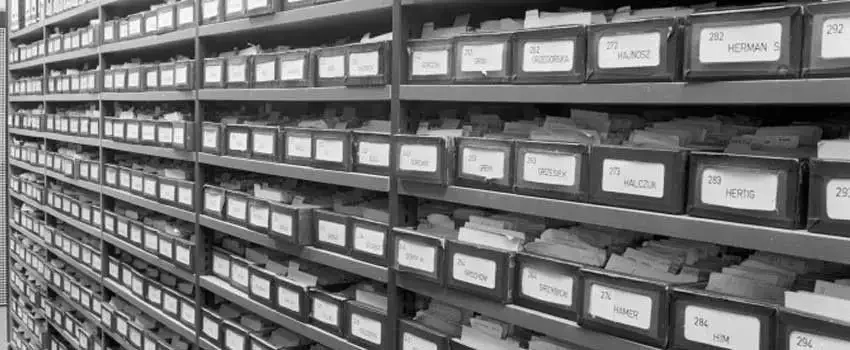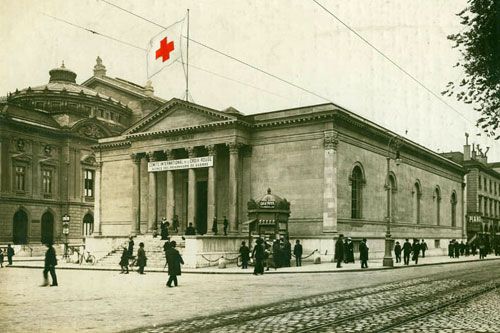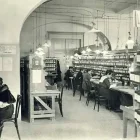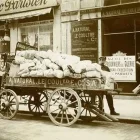- Military History
- Agencies, Organizations & Political Parties
- Central POW Agency

Central POW Agency The Central Prisoner of War Agency of the International Committee of the Red Cross (ICRC)
For over a century, the Central Prisoner of War Agency of the International Committee of the Red Cross (ICRC) has, under a variety of names, acted as the main clearinghouse for information on POWs and civilians interned by all belligerent nations. It was borne of the humanitarian belief that the mental suffering of prisoners and their families could be partly eased by the provision of reliable, current information on the status of prisoners.
The agency has its roots in the International Agency for Aid to Sick and Wounded Military Personnel, commonly known as the Basel Agency. The Basel Agency first served during the Franco-Prussian War of 1870-1871, initially as an intermediary, forwarding as many as 300 letters a day from prisoners held by each side.
Later in the war, the agency attempted to arrange for an exchange of lists of POWs between France and Germany. However, the German government, which held the vast majority of prisoners taken during the war, claimed that it could not provide lists of all the nearly 100,000 French soldiers in its prison camps, and so the agency confined itself to handling information on wounded French prisoners.
During the Balkan Wars that preceded World War I, the Belgrade Agency of the ICRC handled information on POWs captured by Serbia, Bulgaria, Greece, and Turkey. However, for a variety of reasons, the agency's work was unsatisfactory. Red Cross officials believed there had been 250,000 prisoners taken by all sides, but the agency received the names of only 17,000. The names of another 70,000 were received after hostilities, but by then they were of little use to anyone.
At the 9th International Conference of the Red Cross at Washington, DC, in 1912, member delegates agreed that in peacetime, national Red Cross societies should organize commissions that could be activated to serve in wartime as clearinghouses for information about prisoners. In due course, arrangements were made by most national societies, so that when World War I began in August 1914, the ICRC could announce the immediate opening of the International POW Agency.

Again, the Agency focused on securing from all combatant’s complete lists of the prisoners they captured. Typically, these lists were transmitted to Geneva through intermediaries, either the American embassies (for Britain, France, and Germany) or the Danish Red Cross (for Germany and Russia). When the lists reached Geneva, they were collated into an immense color-coded card index. There were also regimental and topographical cross-indices that allowed clerks to locate prisoners in the event of a misspelled name or inadequate information. The card indices were used to respond to inquiries from the public about missing relatives or friends. On average, the agency received around 3,000 letters each day, but during major offensives, that number could grow to 30,000 a day.
Another section of the agency handled the transmission of correspondence, parcels, and money to prisoners, and it, too, made prodigious efforts to assist captives. During the war, this section handled over 1.8 million individually addressed parcels and forwarded the equivalent of 18 million Swiss francs to prisoners. Other departments handled the welfare of prisoners who had been transferred to neutral countries and for inquiries regarding civilians, both interned and at liberty. In 1923, having amassed over 7 million index cards on individual prisoners, the agency concluded its work.
The Central POW Agency (as it was now called) was reactivated in September 1939 and continued working until after World War II. Its organization and procedures were roughly similar to those used in World War I, but new sections were added to handle medical personnel, Jewish refugees, internees in Switzerland, and displaced families. Although the procedures were the same, the work certainly had a broader scope, as the following statistics show: At its peak, the agency had 2,528 workers, most of whom were volunteers. These workers handled an immense volume of material: over 110 million separate pieces of mail and over 560,000 telegrams; nearly 24 million civilian messages (transmitted in special forms); the personal effects of 90,000 individuals; and 36 million index cards, over 10 million for German prisoners alone.
The agency received full cooperation from combatant governments regarding prisoners of war; there was less compliance from most governments regarding interned civilians, particularly the inmates of concentration camps. The Soviet government never submitted complete lists of German prisoners it captured, and the Japanese government was also slow to comply. By June 1943, for example, Tokyo had forwarded to Geneva the names of less than one-third of the Australian POWs it had captured.
Although the agency officially concluded its work in June 1947, for all intents and purposes, it has continued to operate, changing its name one more time. Now the Central Tracing Agency of the ICRC, the agency still acts as an information clearinghouse for prisoners in conflicts around the world, including the Algerian War, the Arab-Israeli War, and the India-Pakistan wars.
As international conflict has changed since 1945, so, too, has the agency. It now relies even more heavily on flexibility, adaptability, and the goodwill of belligerent states to carry out its vital work to support prisoners and their families.
Map
- {{#owner}}
- {{#url}} {{#avatarSrc}}
{{name}} {{/url}} {{^url}} {{#avatar}} {{& avatar}} {{/avatar}} {{name}} {{/url}} - {{/owner}} {{#created}}
- {{created}} {{/created}}



























